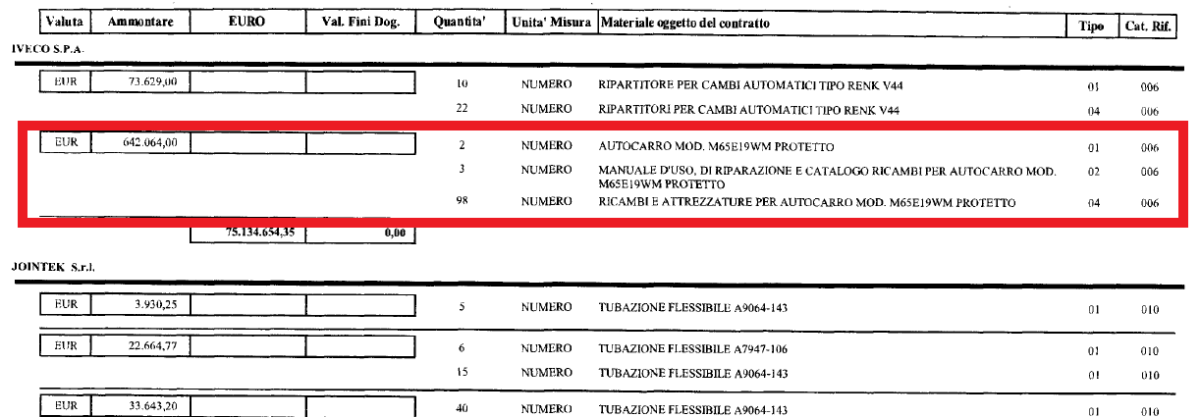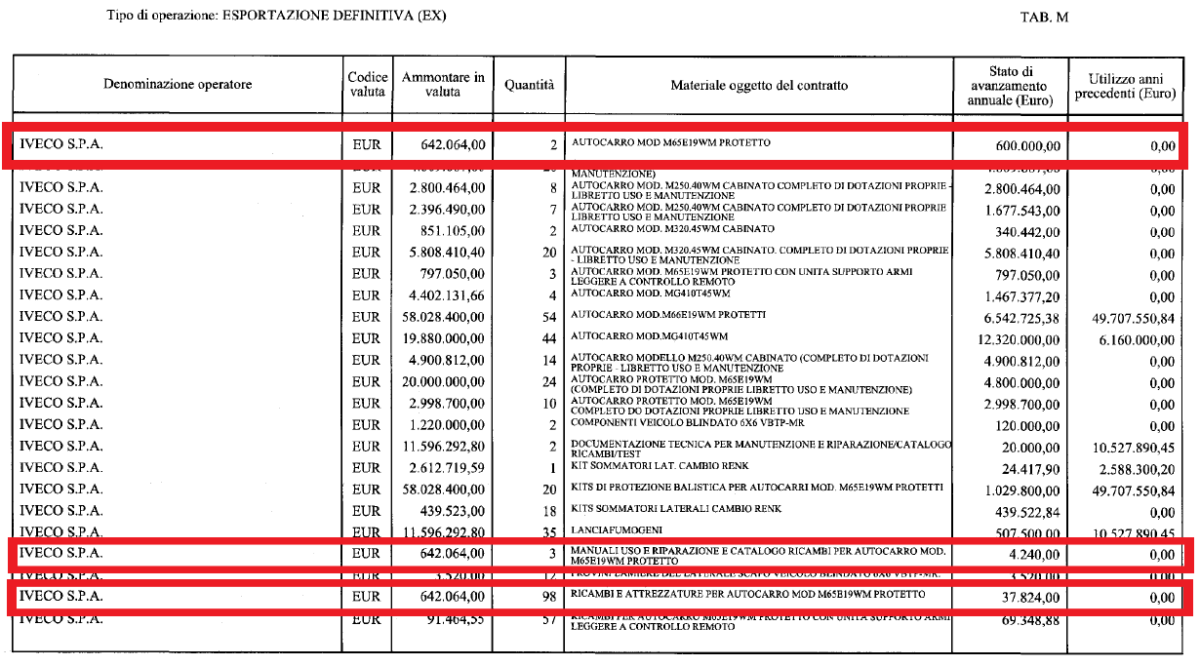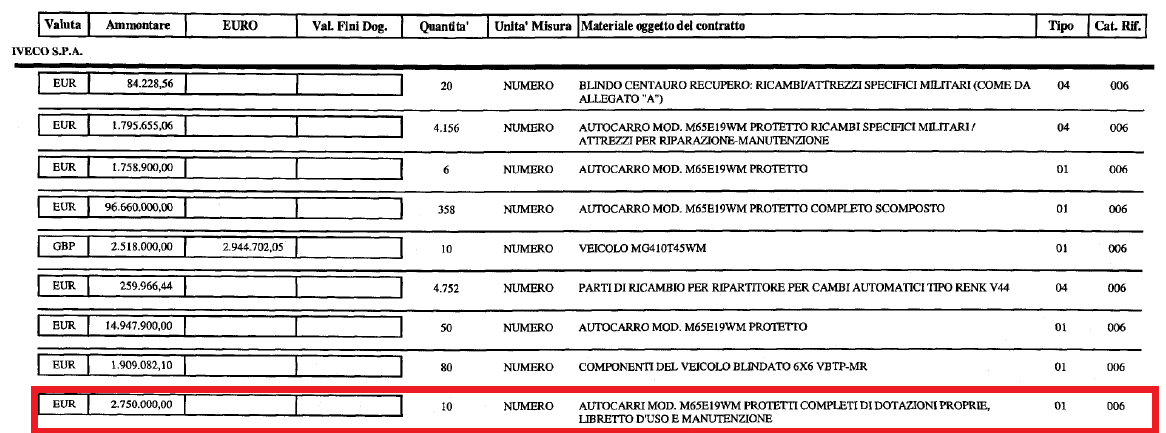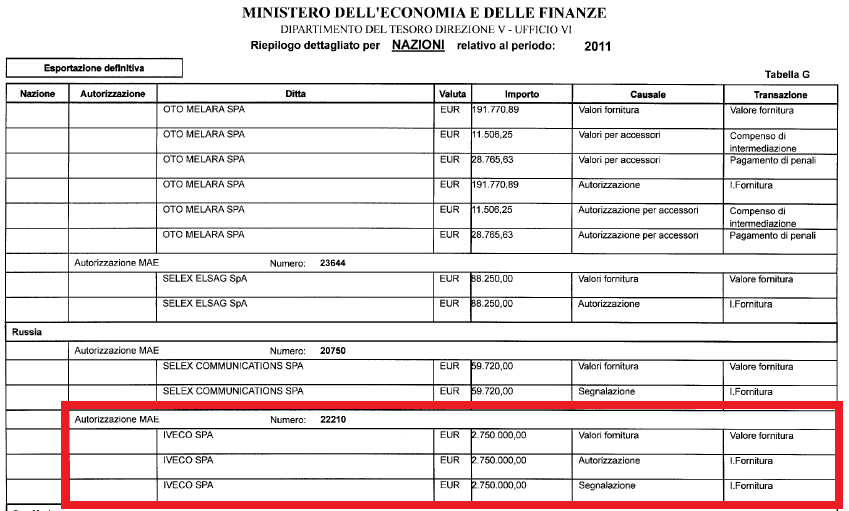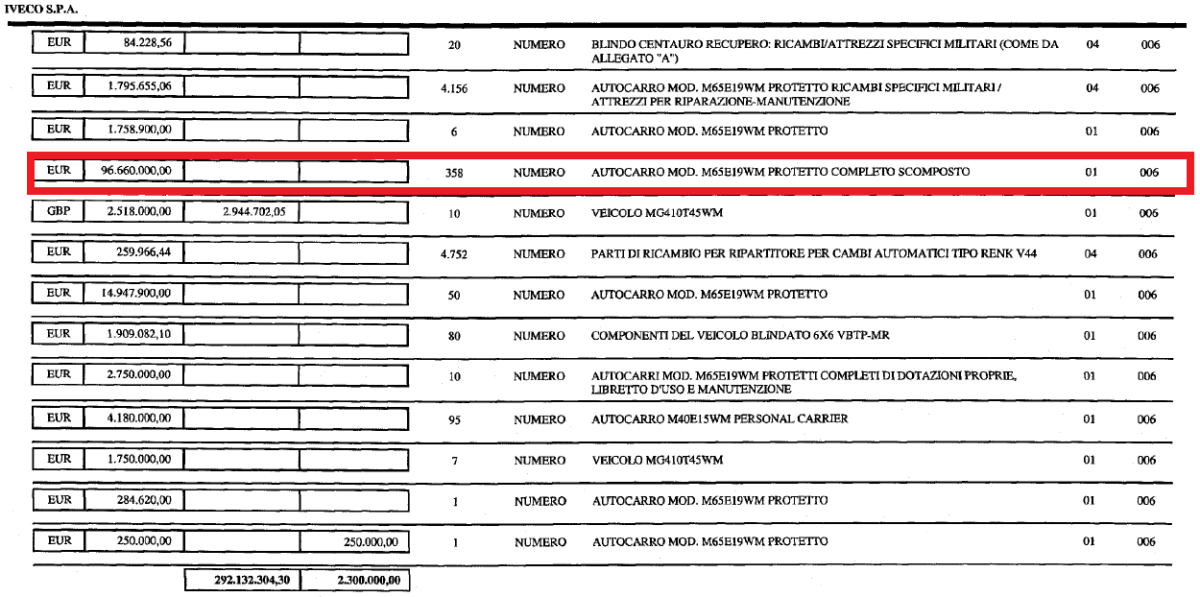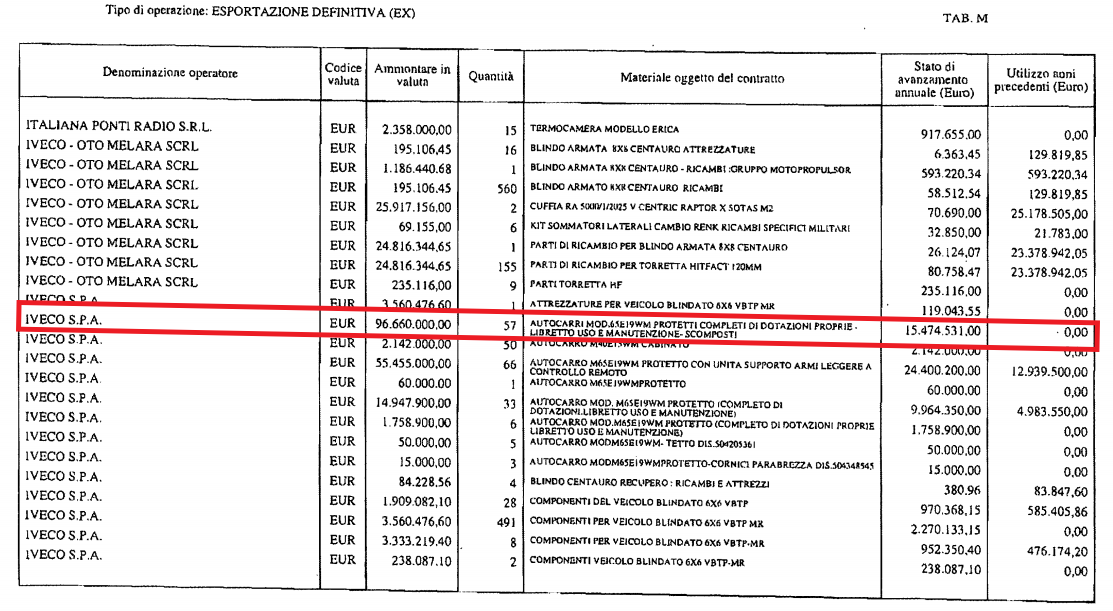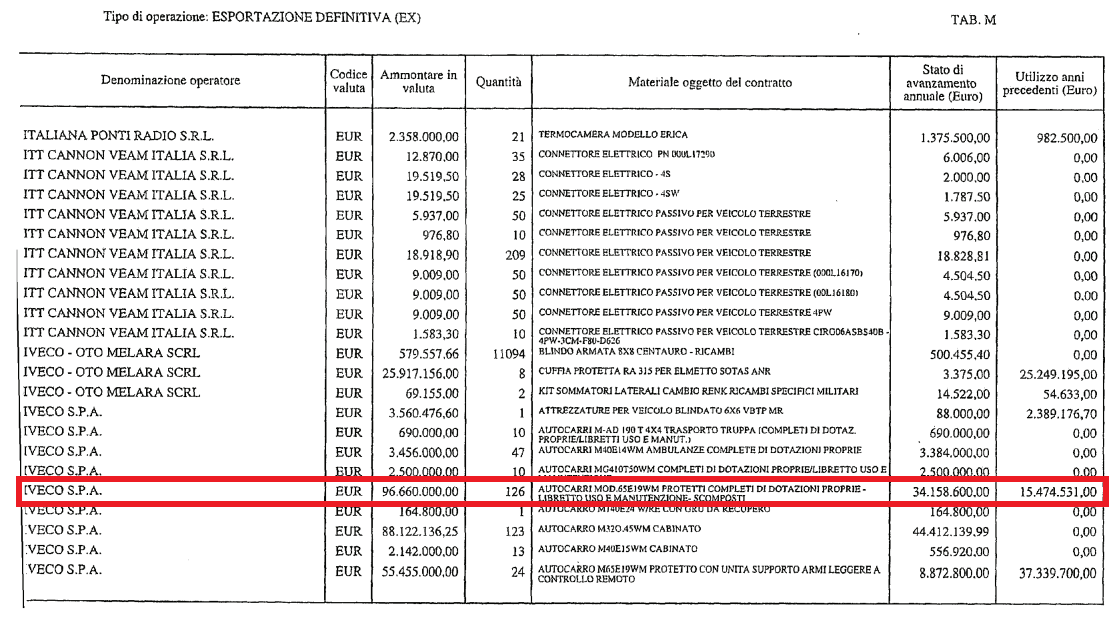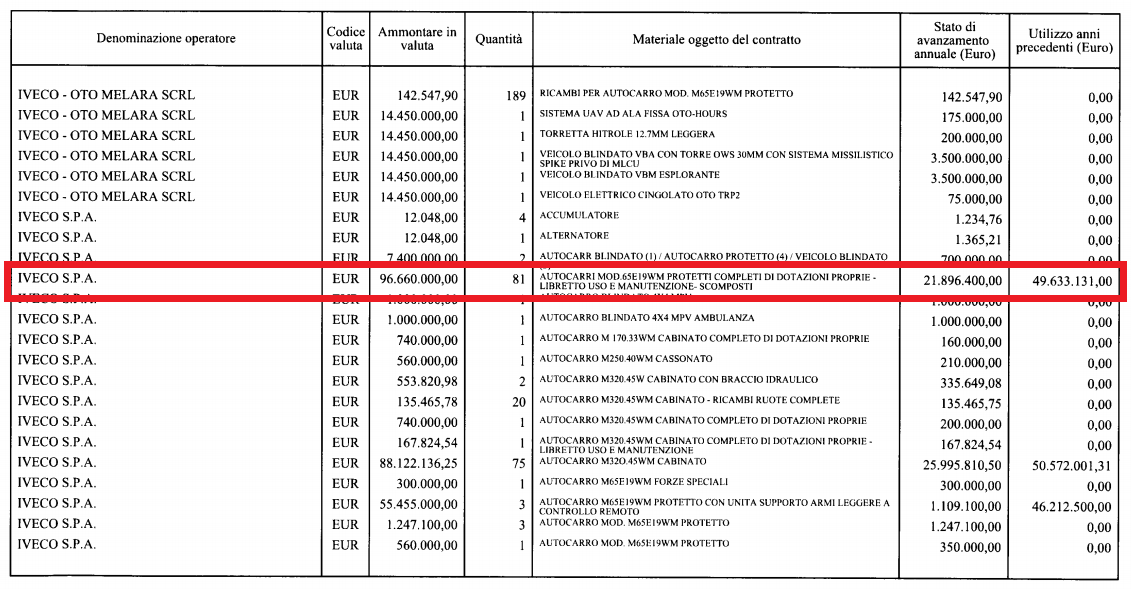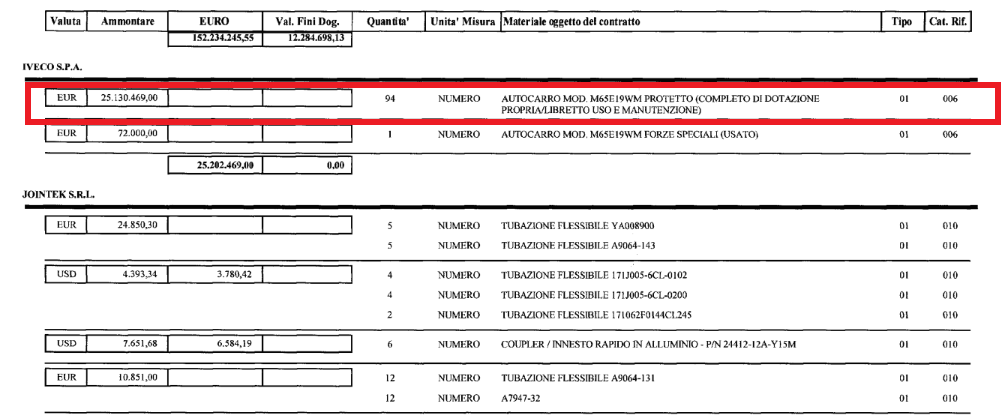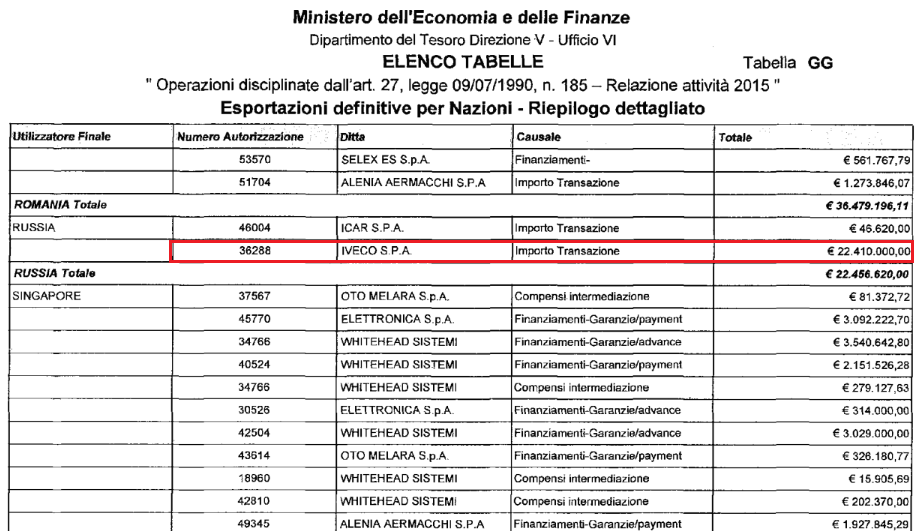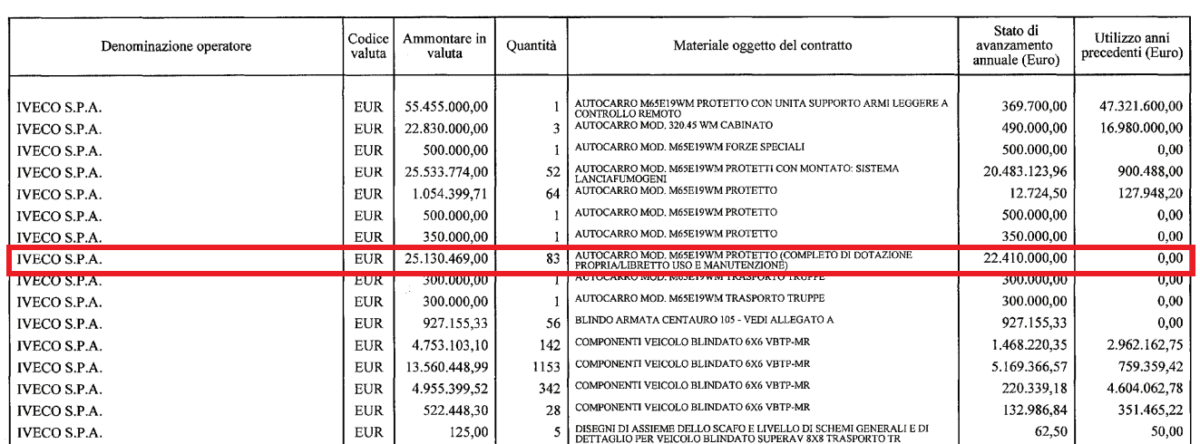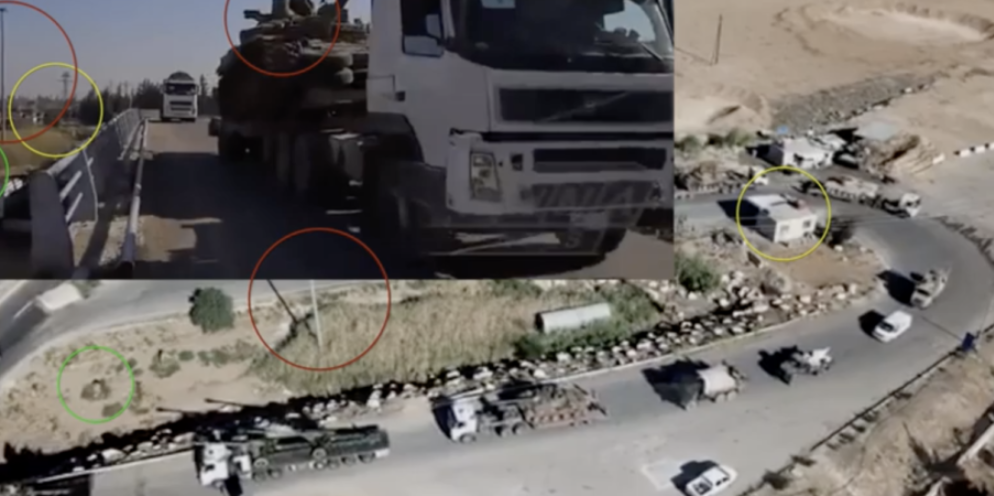The War Trade: How Italy Sold Armoured Vehicles To Russia + Their Deployment With Syrian Army Militias
These findings were made by Benjamin Strick, Leone Hadavi and Bashar Deeb and are a result of a year-long investigation stemming from the EU Arms Project, an investigative collaboration between Bellingcat and Lighthouse Reports. Special thanks to Francesca Costantini who helped us analyse Italian Government reports.
There is a direct prohibition against supplying arms to Russia due to sanctions imposed following its attacks on Ukraine. Italy, however, has supplied Iveco Light Multirole Vehicles (LMVs) to the Russian Defense Ministry after these sanctionatory measures were established.
Meanwhile, the EU Common Position calls for Member States to
- Deny an export licence if there is a clear risk that the military technology or equipment to be exported might be used for internal repression;
- Exercise special caution and vigilance in issuing licenses, on a case-by-case basis […], to countries where serious violations of human rights have been established by the competent bodies of the United Nations, by the European Union or by the Council of Europe;
We have geolocated these vehicles being used, on multiple occasions, within the context of the war in Syria. These were not only operated by Russian military personnel but in some cases also embedded with and/or diverted to local Syrian militia leaders who are under EU sanctions for their responsibility in human rights abuses.
In this report, using open source evidence, we will show:
- What is the Italian Iveco LMV
- How did it get to Syria from Russia
- Where and When the Iveco LMV was being used in Syria
- Who are the EU-sanctioned Syrian militia leaders using the Iveco LMV; and
- Why transactions for the sale of these arms appear to be anomalous.
1. What Is The Iveco Light Multirole Vehicle?

The Iveco LMV (image above from Iveco site), known as “Lince” (Lynx) in Italy, is an off-road capable IED-resistant modular vehicle for transporting troops with a range of different protection levels and armament configurations depending on versions.
2. How The Iveco Got To Syria From Russia
Transport was effected in two ways, by air and by sea. In this footage, the Iveco LMVs are transported with Russian sappers to Syria. The footage can be geolocated to Chkalovsiy Airport in Schyolkovo, Moscow, filmed from here.


The Iveco LMVs rolled off the plane at Syria’s Hmeimim Air Base here.


By sea, Iveco LMVs can be seen passing through the Bosphorus on Russian Navy vessel BSF Saratov (#150) here. Deliveries were also made by BSF Orsk (#148), spotted crossing the Bosphorus reportedly on its way to Syria on at least one occasion, in April 2018, carrying an Iveco LMV, as shown here.

Some of the Iveco LMVs have been spotted at the Port of Tartus in Syria, here.


Of the Iveco LMVs seen in the delivered vehicles above, one has plate number 1100YO94.

The plate number of this Iveco LMV matches the plate number of the Iveco used by Syrian Arab Army’s (SyAA) Tiger Forces commander Suheil Al-Hassan. Al-Hassan is both a controversial and popular leader within the SyAA. Here we can see him on a field tour with Assad in Idlib.

These above are standard Russian military licence plates: as the sample below makes more evident, the last two digits on the plate are smaller than the others but closer to the top edge. That is to make space for “RUS” written at the bottom of the last two digits.

3. Where And When In Syria The Iveco LMV Was Being Used
Tiger Forces Commander Al-Hassan In Aleppo (محطة حلب الحرارية)
Footage uploaded to YouTube on March 18, 2016, shows a scene during the offensive to recapture Aleppo’s Thermal Power Plant. The Iveco LMV seen in the footage is used by Suheil Salman Al-Hassan (سهيل الحسن), commander of the SyAA’s Tiger Forces, or Quwwat al-Nimr (قُوَّات النِّمْر).
Al-Hassan was subjected to EU restrictive measures over the situation in Syria since 2014 and was identified as having given orders to fire directly at protestors in a Human Rights Watch report.

In this footage we can see the Iveco LMV and confirm the make through the various angles it was filmed at below:


Footage can be geolocated by searching for “thermal power plants, Syria” and following the georesults through Wikipedia, providing the following list:

This takes us to this location, East Aleppo Power Station.

Location of attack unfolding in the background can be verified by comparing the imagery with features on the ground.

Chronolocating the event can be done by looking at features identified that would change over time, such as the destruction of the plant, and the smoke. Rather than using Google Earth Pro’s historical slider, Sentinel Hub’s playground browser can be utilised for its more frequent range of satellite imagery.
Specifically, Sentinel Hub has this shot from February 16, 2016.


Layering Sentinel-2 imagery from Sentinel Hub with a fire script made by Pierre Markuse (found here on Github) into Google Earth we can compare the direction of the eastern plume to chronologically match the feature present in the footage and thus to verify its time and location.

Social media images, taken moments after the attack on the Aleppo Thermal Power Plant, also show an Iveco vehicle, likely that of Al-Hassan. We geolocated the image to this location. Note, the vehicle is identified by the green arrow in the bottom left image.

Desert Hawks In Al-Rassafah (الرصافة)
In June 2016, an Iveco LMV was spotted on the road connecting Sufyan oilfields to Tabaqa (foreground, left), next to a Russian GAZ Tigr vehicle (foreground, right).

Sources have described this as part of the offensive carried out by different units belonging to the SyAA. Among these was the Suqour al-Sahraa’ (لواء صقور الصحراء), i.e. the Desert Hawks (or Desert Falcons) Brigade, which deployed from Ithiriya on June 2, 2016, and followed Highway 42 towards Raqqah, with some Russian support.
The main force, after reaching the Safiya crossroad, reportedly headed North leaving Highway 42, past the Sufyan olifields, and attacked ISIS positions while trying to reach Tabaqa airbase. As ISIS counter-attacked, it eventually forced the SyAA to retreat and abandon all previously-occupied territory up until the oilfield.
Footage from the offensive has enabled a more comprehensive look over the area, and allowed us to identify the exact location where the Iveco LMV was spotted.

This variation in elevation, visible looking North from the LMV, has been found on Google Earth imagery as well, after scanning large portions of the road connecting Sufyan oilfields and Tabaqa airbase, and corresponds to the area preceding Thawra oilfield coming from the South.

By analysing this portion of road on other satellite imagery providers, a second line of poles which follows the road (from where we can see the Iveco LMV in line with the top of the hill ahead) is visible. This is another indication that the road visible from the first photograph and the footage matches the one captured from the satellite.

A photograph of the same scene taken from the vehicles’ front allowed us to identify the missing piece: the antenna on the picture’s left edge indicates the position of the Al-Rassafah station, which the convoy had driven through previously from Highway 42. This enables the identification of the section of road of interest between the two points, Thawra and Rassafah.


Using the two photographs and the aforementioned video we were able to geolocate the Iveco LMV to this exact point.

To chronolocate the event we can, again, focus on a fire. In this case the one captured in the RT video we previously mentioned. That video was uploaded to YouTube on June 20, 2016, but was likely recorded before that date. The smoke is coming from the direction of Thawra Industrial Facility, but it does not look like it originated from the facility itself, but rather from a smaller object, possibly a vehicle, closer to the camera and to the side of the road. The Facility’s buildings, in fact, appear more to the background compared to the flames. We can see this in the illustration below, where the Thawra Industrial Facility is located in green, whereas the location of the smoke appears to be coming from a location more to the ‘right’ in the image, as indicated by the red circle.

When comparing Sentinel-2A L1C imagery with Landsat 8 USGS imagery of the area, respectively from June 12 and June 19, 2016, a plume of black smoke is visible rising westward and located ahead of the point where the road slightly turns to the right, shortly before the Industrial Facility. This is consistent with the location and size of the smoke originating from the burning object visible in the video, and is consistent with the geolocation of the Iveco LMV.
Because satellite imagery from June 12, 2016 shows no signs of fires nor of charred soil on that portion of land, and because SyAA units had reportedly abandoned the territory conquered until Thawra following ISIS’ counterattack on June 18, the photograph of the Iveco LMV must have been taken between June 12 and 19, 2016, most likely closer to the latter date.

To further prove the existence and verify the entity of the fire and the direction of its plume of smoke, EOS LandViewer allows to apply a Shortwave Infrared (SWIR) band combination. This enables us to spot, in the portion of land of our interest, a peculiarly hot section which “glows”.
At the center of the first photographs stands Mohammad Jaber (محمد جابر), leader of the Desert Hawks Brigade, wearing sunglasses. Jaber is surrounded by military personnel equipped in a peculiar fashion: the man with a concealed face standing in front of him carries an AK-74 assault rifle and sports a Russian military patch on his left arm; two men in the background — one aboard the Tigr vehicle — wear a 6b47-type-styled helmet.

The particularities in equipment listed above, together with the presence of the Iveco LMV and the GAZ Tigr, suggest that the Russian support to the Suqour al-Sahraa’ was, at the time, significant.
Mohammad Jaber was the leader of the Desert Hawks Brigade, a Shia militia which participated in many battles with the SyAA between 2013 and 2017. Despite several military successes, the unit was reportedly disbanded in August 2017.
Mohammad Jaber, and his brother Ayman Jaber (أيمن جابر), are listed among sanctioned persons by the EU since 2011 for their role in the repression and violence against the civilian population and coordination of Shabiha militias, and for providing economic support to the regime of Bashar Al-Asad.

Desert Hawks/Hezbollah in Palmyra Offensive at Western Bayarat (البيارات الغربية)

This Iveco LMV was spotted on Road 32 which connects the T4 (Tifor) airbase to Palmyra, and appears to be armed with a DShK-type 12.7mm heavy machine gun, most probably mounted on a ring mount on its roof.

Following the review of a significant amount of footage from the Palmyra campaign, this video was found. It was recorded at the same location, apparently only a few seconds before the picture above, and it shows the same Iveco with an open roof hatch in the background.


Two additional videos (1,2), and this picture, all taken around the same location, allow for the geolocation of the Iveco LMV to this position.

The main picture was first published on Syrian Arab News Agency’s (SANA) website on February 17, 2017. According to Wikimapia, the area in which the Iveco was geolocated is called Western Bayarat (البيارات الغربية).

Al-Masdar News published this map on February 14, 2017 announcing SyAA’s seizure of Hayan gasfield/oilfield:

On February 15, SANA published a video showing combat footage around Hayan gasfield. This narrows down the date of the image between February 14 and 17, 2017.
The Palmyra campaign started on January 13 and ended on March 3 with SyAA taking back control over the ancient city, its surrounding hills and gas/oil fields. Hezbollah and the Desert Hawks Brigade were among the units who participated in the campaign.
This RT report on SyAA’s advance in Palmyra includes an interview with a soldier. The badge on his left arm reads قوات صقور الصحراء, “Desert Hawks Forces”.

We have geolocated this footage. It was recorded from this hill, near the triangle of Palmyra:

Al-Manar TV, a Lebanese channel which is banned in different countries for its links to Hezbollah(1, 2)reported on the participation of Hezbollah to the Palmyra offensive while visiting one of Hezbollah’s defensive positions. The report (archived) includes pictures of soldiers standing on a hill behind trenches, and interviews with soldiers who spoke from a Lebanese perspective about the strategic importance of Palmyra.
One of these defensive positions, with a soldier standing behind sandbags, was geolocated to this hill (an alternative picture which allows better analysis was found on Twitter).

4. Why Transactions For The Sale Of These Arms Appear To Be Anomalous
Iveco Export Licence Authorised In 2009
The 2009 Report to Italy’s parliament on the sale and export of military equipment stated that Iveco was granted a licence by the Italian Ministry of Foreign Affairs (MFA) to export:
- 2x model M65E19WM armoured vehicles
- 3x manuals; and
- 98x spare parts and tools for the same vehicle model
The total value for this licence was €642.064,00. We have provided a screenshots below of the reports where this is indicated in the red box (Attachment 1; “model M65E19WM” is the original name). These screenshots below correlate to any further mentions of the related attachments.
In the report by the Ministry of Economy and Finances (MEF) concerning concluded exports, the same amount is mentioned for payments made by Russia.
From this, we can tell the following:
- The licence’s number is 17977 (seen in attachment 2)
- It was paid for in full in 2009 (attachment 2) and;
- Its items were wholly exported by the same year (seen in attachment 3)
Iveco Export Licences Authorised In 2011
In 2011, another authorization by the MFA granted Iveco the sale of 10 M65E19WM armoured vehicles for €2.750.000,00. This can be seen in attachment 4.
By comparing the license values we can say that this was licence number 22210. It was paid for, in its entirety, by Russia in 2011 (seen in attachment 5) and its content was exported in the same year (seen in attachment 6) as indicated by the Customs Agency.
Another authorization released in 2011 allowed for 358 M65E19WM disassembled vehicles to be exported by Iveco for €96.600.000,00 (attachment 7). No payments referring to this licence have been found in Italian Government documents — up to the year 2018, i.e. the latest available data — where payments related to arms exports are usually reported.
At the same time, exports originating from this licence have occurred in:
- 2012 (€15.474.531,00 for 57 vehicles – attachment 8)
- 2013 (€34.158.600,00 for 126 vehicles – attachment 9) and;
- 2014 (€21.896.400,00 for 81 vehicles – attachment 10).
This order has seemingly not been fully exported (264 vehicles delivered up to 2014). However, Jane’s reported in 2014 that Russia had just concluded assembly of 358 armoured vehicles from Iveco following an order placed in 2011 [ITAR-TASS original statement], and that it would not assemble more.
Official government documents, instead, tell a different story:
- 264 vehicles were only exported by 2014, and not by 2013;
- 358 vehicles will be only exported by 2015 (and not even then) — as shown below — and not by 2014.
Iveco Export Licence Authorised In 2015
In 2015, a new authorization was issued for the sale of 94 M65E19WM armoured vehicles for the value of €25.130.469,00 (seen in attachment 11).
By comparing the values we can tell:
- This was license number 36288
- A payment concerning this licence was made by Russia for €22.410.000,00 (seen in attachment 12); and
- 83 vehicles out of the lot of 94 were exported in the same year (seen in attachment 13).
By adding the 94 vehicles of the 2015 license to the 264 exported by 2014 of the 2011 license, we obtain 358 of the original lot.
At the same time, the 2011 license had not been fully exported, and the relative payments are missing from arms exports data. Operations regarding this vehicle’s model to Russia do not appear in following years’ reports.
An Arms Embargo
On July 31, 2014, the EU adopted Council Decision 2014/512/CFSP concerning restrictive measures in view of Russia’s actions destabilising the situation in Ukraine.

Of particular interest and relevance are the provisions within Article 2 Paragraph 1 of the Decision:

These measures have been renewed regularly since their adoption in July 2014, until the latest Decision, in June 2019, that extends the sanction until July 31, 2020.
As with every sanction, this one too has its waivers, which are contained in Paragraphs 4 to 7. Only Paragraph 4 is pertinent:

This provision exempts any contract stipulated before August 1 2014 or additional contracts necessary for the completion of previously-granted ones from being sanctioned, and does not require prior authorization nor for the Council to be informed.
The authorisation of the new license for the sale of 94 M65E19WM armoured vehicles for the value of €25.130.469,00 was granted after Decision 2014/512/CFSP was adopted.
Summary Points
In this open source investigation, we have shown you the path of the Iveco LMV as it was sold to Russia from Italy, with government-granted export licences.
We have identified some of these exports to be in breach of the EU Common Position, as well as being licensed after the establishment of sanctions placed on Russia by the EU.
On the ground level, we have identified why these safeguards exist in the first place — that is, to stop European arms ending up in the hands of EU-sanctioned militia leaders who have been responsible for acts against human rights.
Through geolocation and chronolocation, we have identified how the Italian vehicles arrived in Syria, and where and when these vehicles have been in use by those leaders. Furthermore, they continue to be in use by Syrian Army and Russian forces in 2019.


